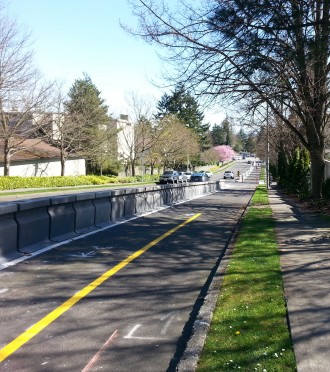![]() Seattle is building a network that puts all residents within ¼ mile of a bike facility. The goal is to make riding a bike a comfortable part of daily life for everyone. Cycle tracks, or protected bike lanes, are one piece of the network. Cycle tracks help eliminate perceived risk and fear of collisions; reduce the risk of crashes into opening car doors; and add a level of predictability that makes streets safer for everyone.
Seattle is building a network that puts all residents within ¼ mile of a bike facility. The goal is to make riding a bike a comfortable part of daily life for everyone. Cycle tracks, or protected bike lanes, are one piece of the network. Cycle tracks help eliminate perceived risk and fear of collisions; reduce the risk of crashes into opening car doors; and add a level of predictability that makes streets safer for everyone.
Cycle tracks are physically separated (by grade or barrier) from motor traffic and are distinct from the sidewalk. They have different forms, but all share common elements—they provide space that is primarily used for bicycles and are separated from motor vehicle travel lanes, parking lanes, and sidewalks.
Currently, Seattle is constructing two-way cycle tracks on one side of the street. This may vary as new facilities are added. The photo above is the two-way cycle track on NE 65th St near Sand Point Way. It serves as a safe way to get from Burke-Gilman Trail to Magnuson Park.
Here are directions on how to use a cycle track:
Bicyclists
- Watch for turning vehicles when approaching intersections, driveways and alleys.
- Be alert for passing bicyclists within the bike lane and for pedestrians crossing the bike lane to access parked motor vehicles.
- Be aware that the bike lane may weave as it approaches intersections to make bicyclists more visible to motorists.
- Stay to the right and allow faster users to pass safely on the left.
- Yield to pedestrians and wheelchair users who may be crossing the road and protected bike lane and give an audible signal before overtaking and passing any pedestrian.
Pedestrians
- Watch and listen for protected bike lane users traveling from either direction just as you would when crossing a street.
- Cross protected bike lane at crosswalks.
- Be alert for nearby cyclists when crossing a protected bike lane to access a parked vehicle.
Wheelchairs
- Wheelchair-bound travelers are allowed to use bicycle lanes and public roads that have speed limits below 35 mph. Individuals determine what is most comfortable and must follow the same rules as other protected bike lane users.
Motorists
- Park in the marked lane between the travel lane and the bike lane in instances where on-street parking is available.
- Take extra caution and look both ways before turning across the bike lane at intersections, driveways and alleys, especially when the barrier-protected bike lane is protected by on-street parking.
- Watch for people on bikes traveling in both directions in two-way protected bike lanes.
- Remember through-bicyclists have the right-of-way at uncontrolled intersections, driveways and alleys.
- Don’t drive in a protected bike lane. You can turn across a protected bike lane, but must yield to bicycles.
Motorized scooters may not use cycle tracks.



hooray!! THIS is a bicycling plan that makes sense. I have never understood the idea that a fading line of paint on a busy road would in any way serve bicyclists except to give a false sense of security. Of course I’m more of a driver than a bicyclist and might find myself grumpy the slowed traffic the narrower streets might cause – but that’s the compromise of living in a vibrant city…
Thanks for posting this, Nancy!
Does anyone know what it means when there’s a bicycle with two chevrons above it in the middle of a driving lane?
?
The bike with chevrons is a reminder to motorists that bicycles frequently use that route and they need to share the road. They’re also called “sharrows”.